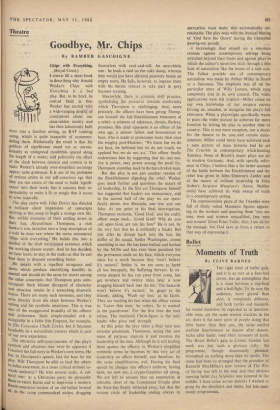Ballet
Moments of Truth
By CLIVE BARNES
THE right kind of ballet gala, and it is as rare as a four-leaf clover, has an atmosphere that is a cross between a cup-final and a bull-fight. To be sure the audience, more glazed than alert, is completely different, and both rattles and banderil- las would doubtless be regarded as in' question- able taste, yet the same tension crackles in the air, there is the same spirit of people doing that little better than they can, the same excited stadium heartlessness as dancer after dancer, ballet after ballet, meet their moments of truth. The Royal Ballet's gala at Covent Garden last week was just such a glorious folly: the programme, though disastroully planned, triumphed on nothing more than its merits. The items had been so arranged that the preini&e of Kenneth MacMillan's new version of The Rite of Spring was left to the end, and that obvious opening ballet Les Sylphides was jammed in the middle. I have come across dancers I wanted to grasp by the shoulders and shake, but less com- monly programmes. MacMillan's disturbing Rite of Spring, which I take at first glance to be among the most signi- ficant ballets to be produced since the war, is fascinating in its musical awareness, moving in its suggestion of post-atomic holocaust as well as prehistoric ritual. I shall return to It later. The more obviously gala elements of the gala were led off by a divertissement from Bournonville's Napoli. In Copenhagen the Royal Danish ballet still preserves a whole repertory of Bournon- ville works dating from the middle of the last century. Handed on from one generation of Danish dancers to the next, these ballets repre- sent the most perfect examples of Romantic choreography extant, and it was high time Covent Garden followed the lead of Festival Ballet and the Ballet Rambert by including some. Bournonville in its repertory. The present ex cerpt, produced by Erik Bruhn, is pure dancing, buoyant, gay and unaffectedly pretty. The group of young Royal Ballet soloists dance splendidly with the authentic soft brilliance Bournonville demands. Immediately afterwards, Bruhn him- self took the stage with Nadia Nerina for an- other Bournonville party-piece, the famous pas de deux from The Flower Festival in Genzano. The unrivalled Bruhn is, among other things, the noblest Bournonville stylist of our day, a sort of bel canto dancer. Nerina matched him in vir- tuosity, but a trace of her normal Anglo-Russian accent here detracted from the purity of her dancing.
Frederick Ashton's new pas de deux from Raymonda was an ideal showpiece for the ease and authority of Svetlana Beriosova and her partner Donald MacLeary. Its grandeur and invention (more reminiscent of Tchaikovsky than the pale Glazunov to which it is set) in- corporates Soviet-style lifts with a typically Ashton brand of bravura lyricism. It was an evening of surprises. Even Les Sylphides came to us with a difference. Nureyev, dancing the ballet for the first time here, substituted Fokine's rare, alternative male solo for the Mazurka we are accustomed to in the West. This more flam- boyant solo, which Fokine choreographed in Russia, is still danced by 'Nureyev's parent company, the Kirov Ballet, and I believe it was seen in Britain when Fokine revived Les Sylphides for the Rene Blum company in 1936. It is better suited to Nureyev's unfettered dancing than the familiar variation.



































 Previous page
Previous page